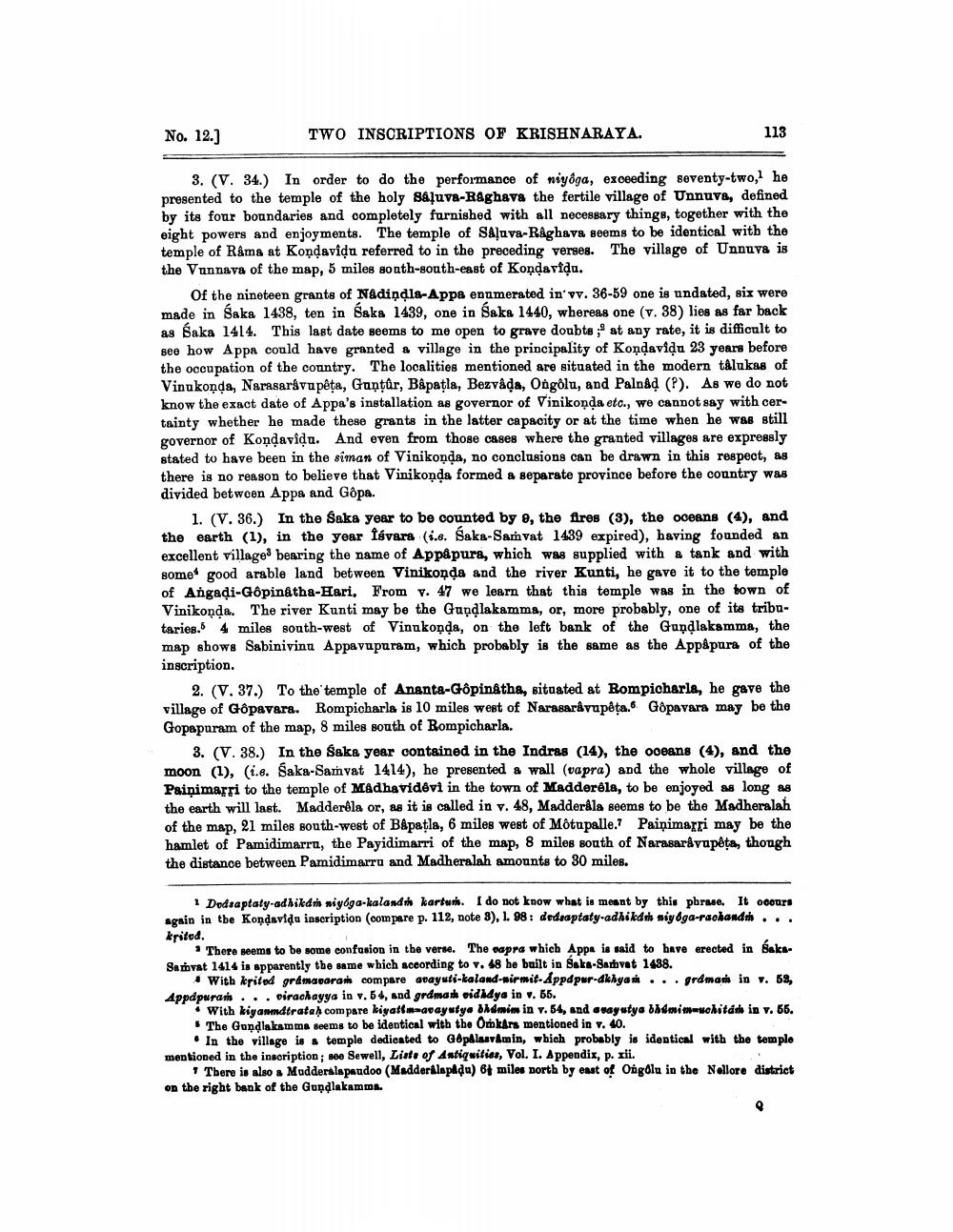________________
No. 12.)
TWO INSCRIPTIONS OF KRISHNARAYA.
113
3. (V. 34.) In order to do the performance of niyôga, exceeding seventy-two, he presented to the temple of the holy S&ļuva-R&ghava the fertile village of Unnuve, defined by its four boundaries and completely furnished with all necessary things, together with the eight powers and enjoyments. The temple of Saļuva-Raghava seems to be identical with the temple of Råma at Kondavidu referred to in the preceding verses. The village of Unnuya is the Vunnava of the map, 5 miles south-south-east of Kondavidu.
Of the nineteen grants of Nadiņdla-Appa enumerated in'vv. 36-59 one is undated, six were made in Saka 1438, ten in Saka 1439, one in Saka 1440, whereas one (v. 38) lies as far back as Saka 1414. This last date seems to me open to grave doubts ;' at any rate, it is difficult to see how Appa could have granted & village in the principality of Kondavidu 23 years before the occupation of the country. The localities mentioned are situated in the modern tålukas of Vinukonda, Narasarávupóta, Guntur, Bapatla, Bezvada, Ongolu, and Palnad (P). As we do not know the exact date of Appa's installation as governor of Vinikonda etc., we cannot say with certainty whether he made these grants in the latter capacity or at the time when he was still governor of Kondavidı. And even from those cases where the granted villages are expressly stated to have been in the siman of Vinikonda, no conclusions can be drawn in this respect, as there is no reason to believe that Vinikonda formed a separate province before the country was divided between Appa and Gôpa.
1. (V. 36.) In the Saka year to be counted by e, the fires (3), the oceans (4), and the earth (1), in the year Isvara (1.6. Saka-Samvat 1439 expired), having founded an excellent village bearing the name of App&pure, which was supplied with a tank and with some good arable land between Vinikonda and the river Kunti, he gave it to the temple of Angadi-Gôpinatha-Hari, From v. 47 we learn that this temple was in the town of Vinikonda. The river Kunti may be the Guņdlakamma, or, more probably, one of its tributaries. 4 miles south-west of Vinukonda, on the left bank of the Grandlaksmma, the map shows Sabinivina Appavupuram, which probably is the same as the App&pura of the inscription.
2. (V. 37.) To the temple of Ananta-Gôpingtha, situated at Rompicharla, he gave the village of Gôpavara. Rompicharla is 10 miles west of Narasaråvapêţa. Gópavara may be the Gopapuram of the map, 8 miles south of Rompicharla.
3. (V. 38.) In the Saka year contained in the Indras (14), the oceans (4), and the moon (1), (i.6. Saka-Samvat 1414), he presented a wall (vapra) and the whole village of Painimarri to the temple of Madhavidêvi in the town of Madderéls, to be enjoyed as long as the earth will last. Madderbla or, as it is called in v. 48, Madderála seems to be the Madheralah of the map, 21 miles south-west of Bapatla, 6 miles west of Môtupalle. Paiņimarri may be the hamlet of Pamidimarrn, the Payidimarri of the map, 8 miles south of Narasarayapêta, thongh the distance between Pamidimarru and Madheralah amounts to 30 miles.
1 Dodsaptaty-adhikdra niyog a-kalandu kartus. I do not know what is meant by this phrase. It occurs again in the Kondavidu inscription compare p. 112, note 8), l. 88: dedeaptaty-adhikdy niyoga-rachanda ... kritod.
1 There seems to be some confusion in the verse. The vapra which Appa is said to have erected in Saks Sarhvat 1414 is apparently the same which according to v. 48 be built in Baka-Sathvat 1488.
With krited gråmaparan compare arayuti-kaland-wirmit. Appdpur-dkhyasi... grdmania in v. 58, Appd purato... cirachayya in v. 54, and grdmas cidadya in v. 66.
With kiyanndtratan compare kiyat maarayutya bhdmim in v. 54, and arayutya mimewehitado in v. 65.
The Gundlakamma seems to be identical with the Orokars mentioned in v. 40.
. In the village is a temple dedicated to Gepalsavimin, which probably is identical with the temple mentioned in the inscription; se Sewell, List of Antiquities, Vol. I. Appendix, p. xii.
There is also Mudderslapuudoo (Madderklapdda) 64 miles north by east of Ongolu in the Nellore district on the right bank of the Guņdlakamma.




